Experimental Study on the Acid Fracturing Fracture Propagation Law of a Fractured Carbonate Reservoir in the Majiagou Formation
Abstract
1. Introduction
2. Experimental Method
2.1. Experimental Devices
2.1.1. Control System
2.1.2. Injection System
2.1.3. Stress Loading System
2.1.4. Multi-Channel Acid Alternating Injection System
2.2. Sample Preparation
2.3. Experimental Scheme
2.4. Experimental Procedures
3. Results and Analysis
3.1. Effect of Fracturing Fluid Types
3.2. Effect of Injection Rates
3.3. Effect of Injection Method
3.4. Effect of NFs
4. Discussion
5. Conclusions
Author Contributions
Funding
Data Availability Statement
Conflicts of Interest
References
- Mou, J. Modeling Acid Transport and Non-Uniform Etching in a Stochastic Domain in Acid Fracturing; Texas A&M University: College Station, TX, USA, 2010. [Google Scholar]
- Mou, J. Principle of Acidizing Stimulation Technology; Petroleum Industry Press: Beijing, China, 2023. [Google Scholar]
- Zhang, X.; Zhang, S.; Mou, J. Numerical investigation of hydraulic fracture propagation behavior in vuggy, naturally fractured carbonate reservoir—A case study of shunbei oil field. Geoenergy Sci. Eng. 2024, 242, 213257. [Google Scholar] [CrossRef]
- Deng, J.; Hill, A.; Zhu, D. A theoretical study of acid-fracture conductivity under closure stress. SPE Prod. Oper. 2011, 26, 9–17. [Google Scholar] [CrossRef]
- Salimi, S.; Ghalambor, A.; Hayer, H. Insights Into the Process of Effectively Acidizing Naturally Fractured Reservoirs. In Proceedings of the SPE International Symposium and Exhibition on Formation Damage Control, Lafayette, LA, USA, 26–28 February 2014. SPE-168126-MS. [Google Scholar]
- Panga, M.; Ziauddin, M.; Balakotaiah, V. Two-scale continuum model for simulation of wormholes in carbonate acidization. AIChE J. 2010, 51, 3231–3248. [Google Scholar] [CrossRef]
- Taylor, K.; Nasr-El-Din, H. Laboratory evaluation of in-situ gelled acids for carbonate reservoirs. SPE J. 2003, 8, 426–434. [Google Scholar] [CrossRef]
- Ugursal, A.; Zhu, D.; Hill, A. Development of Acid Fracturing Model for Naturally Fractured Reservoirs. SPE Prod. Oper. 2019, 34, 735–748. [Google Scholar] [CrossRef]
- Gou, B.; Ma, H.; Liu, Z. Research progress and prospect of numerical modeling for acid fracturing of heterogeneous carbonate reservoirs. Nat. Gas Ind. 2019, 39, 87–98. [Google Scholar]
- Zeng, Q.; Li, T.; Bo, L. Effect of acid pre-treatment on hydraulic fracturing in heterogeneous porous media. Geoenergy Sci. Eng. 2025, 246, 213601. [Google Scholar] [CrossRef]
- Budong, G.; Jianye, M.; Panpan, L. Numerical investigation into the acid flow and reaction behavior in the tight, naturally fractured carbonate reservoir during acid fracturing. Phys. Fluids 2024, 36, 113614. [Google Scholar]
- Guo, J.; Bo, G.; Dengyun, L. Advance and prospect of acid fracturing in deep carbonate reservoirs. Drill. Prod. Technol. 2024, 47, 121–129. [Google Scholar]
- Zheng, H.; Liao, R.; Cheng, N. Study of mechano-chemical effects on the morphology of hydraulic fractures. J. Pet. Sci. Eng. 2021, 206, 109031. [Google Scholar] [CrossRef]
- Li, C.; Wang, Y.; Deng, P. Influences of gelled acid on mechanical properties of the ordovician carbonate rocks in block shunbei, Tahe oilfield. Xinjiang Pet. Geol. 2018, 39, 689–695. [Google Scholar]
- Guo, J.; Ren, J.; Wang, S. Numerical simulation and application of multi-field coupling of acid fracturing in farctured tight carbonate reservoirs. Acta Pet. Sin. 2020, 41, 1219–1228. [Google Scholar]
- Aljawad, M.; Schwalbert, M.; Mahmoud, M. Impacts of natural fractures on acid fracture design: A modeling study. Energy Rep. 2020, 6, 1073–1082. [Google Scholar] [CrossRef]
- Gou, B.; Zhan, L.; Guo, J. Effect of different types of stimulation fluids on fracture propagation behavior in naturally fractured carbonate rock through CT scan. J. Pet. Sci. Eng. 2021, 201, 108529. [Google Scholar] [CrossRef]
- Wang, Y.; Hou, B.; Zhang, K. Laboratory true triaxial acid fracturing experiments for carbonate reservoirs. Pet. Sci. Bull. 2020, 3, 412–419. [Google Scholar]
- Mohtarami, E.; Baghbanan, A.; Eftekhari, M. Investigating of chemical effects on rock fracturing using extended finite element method. Theor. Appl. Fract. Mech. 2017, 89, 110–126. [Google Scholar] [CrossRef]
- Zhang, N.; Chen, X.; Luo, Z. Experimental study of fracture conductivity in dolomite reservoirs treated with different acid fracturing technologies. Geoenergy Sci. Eng. 2023, 227, 211914. [Google Scholar] [CrossRef]
- Hou, B.; Zhang, R.; Chen, M. Investigation on acid fracturing treatment in limestone formation based on true tri-axial experiment. Fuel 2019, 235, 473–484. [Google Scholar] [CrossRef]
- Zhang, K.; Chen, M.; Zhou, C. Study of alternating acid fracturing treatment in carbonate formation based on true tri-axial experiment. J. Pet. Sci. Eng. 2020, 192, 107268. [Google Scholar] [CrossRef]
- Su, X.; Qi, N.; Lu, Y. Experimental study on acid etching mechanism of acid fracturing in carbonate reservoirs. Geoenergy Sci. Eng. 2024, 241, 213079. [Google Scholar] [CrossRef]
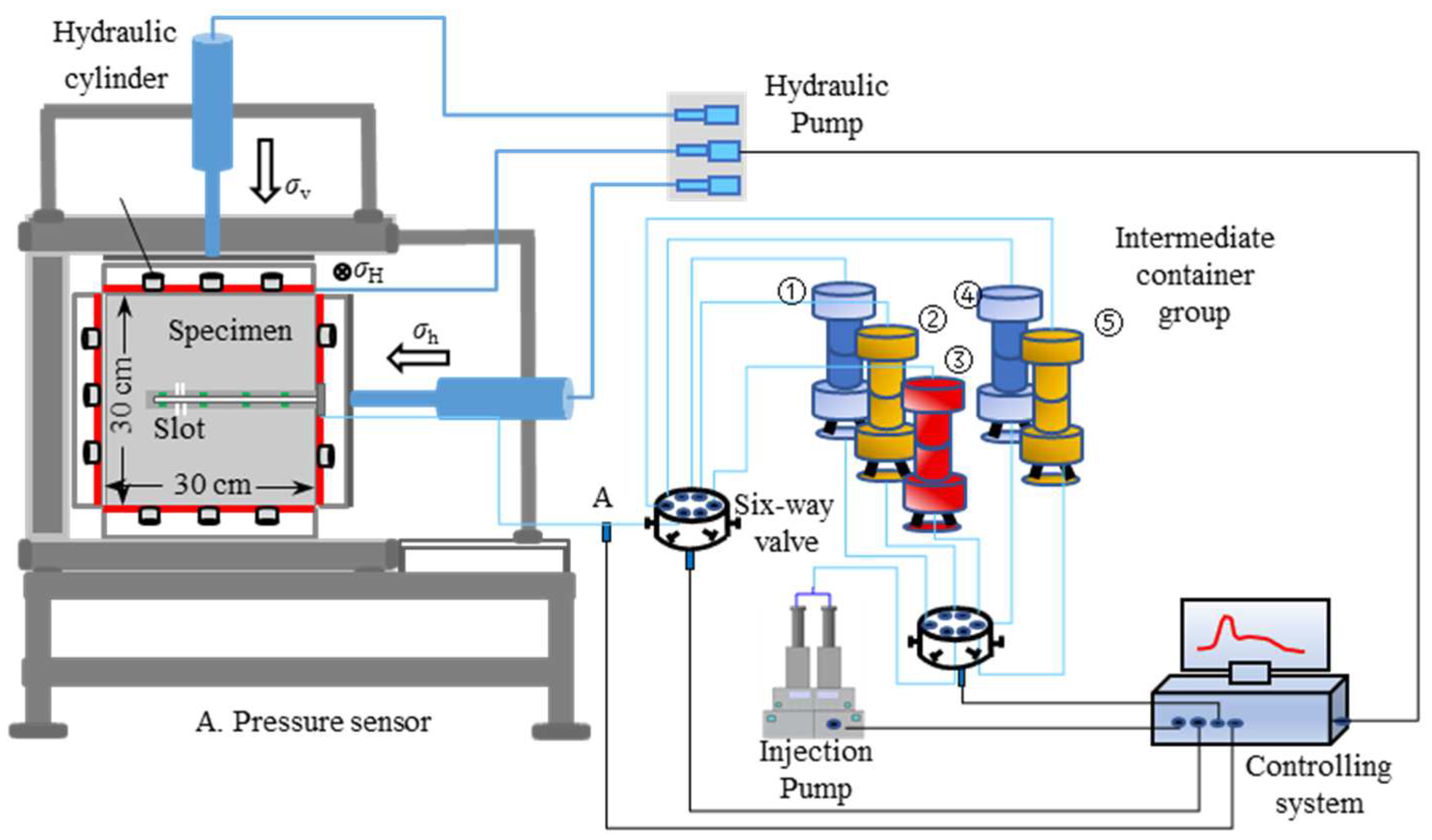
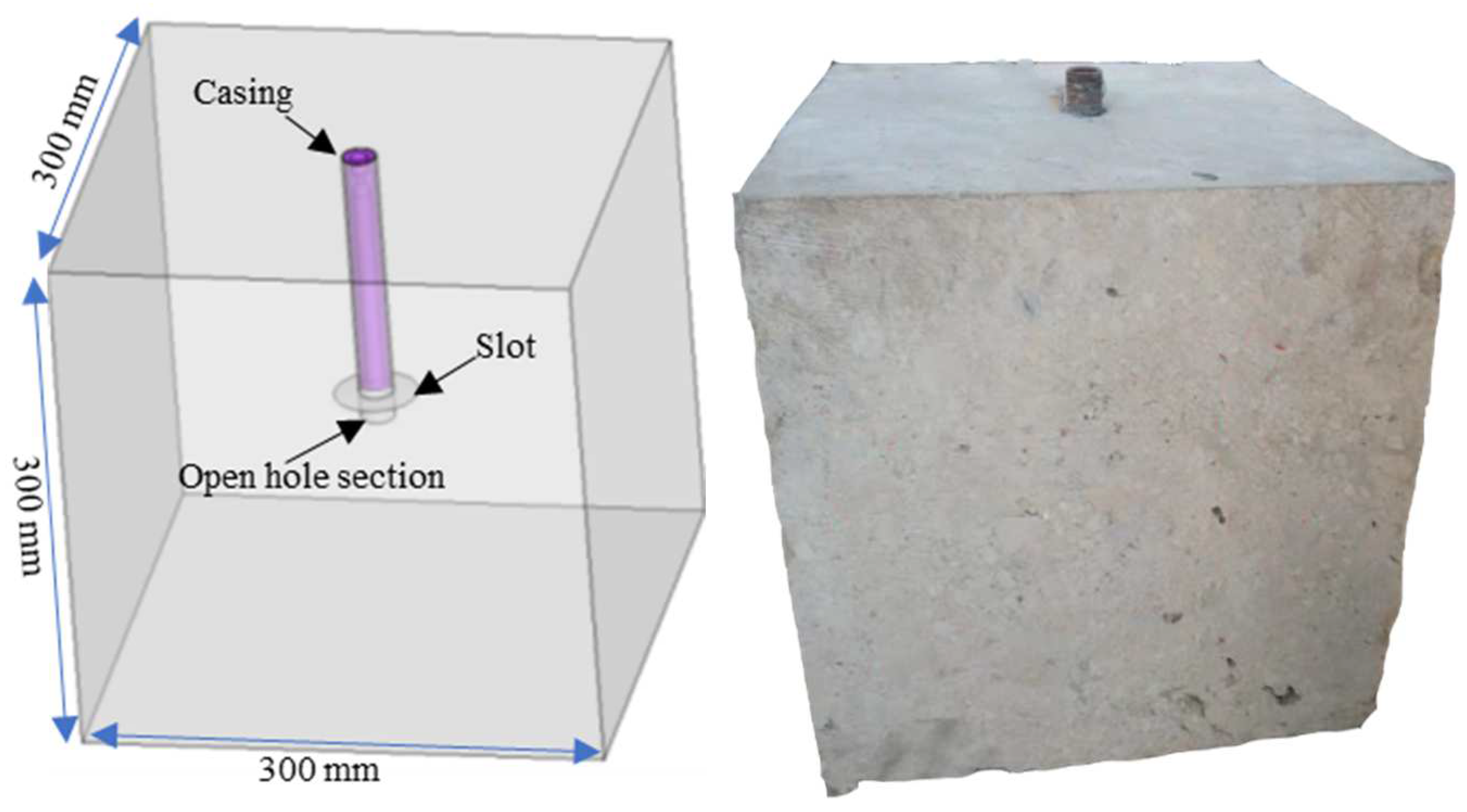
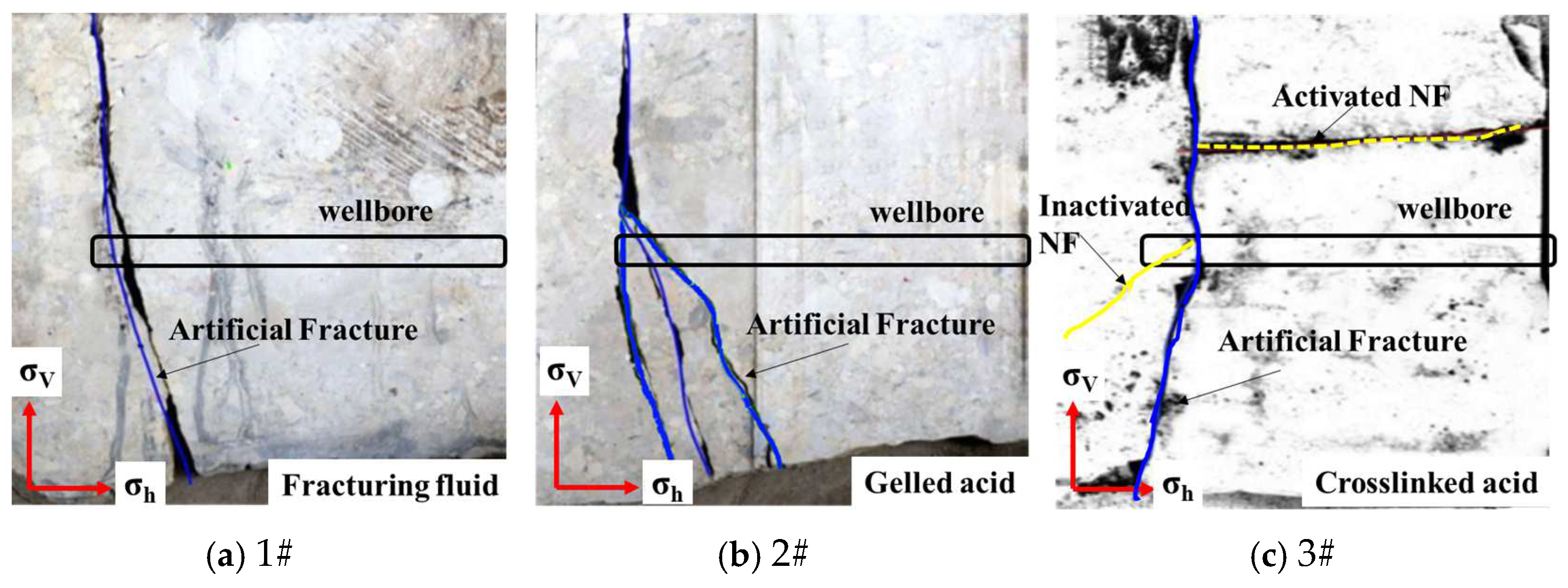

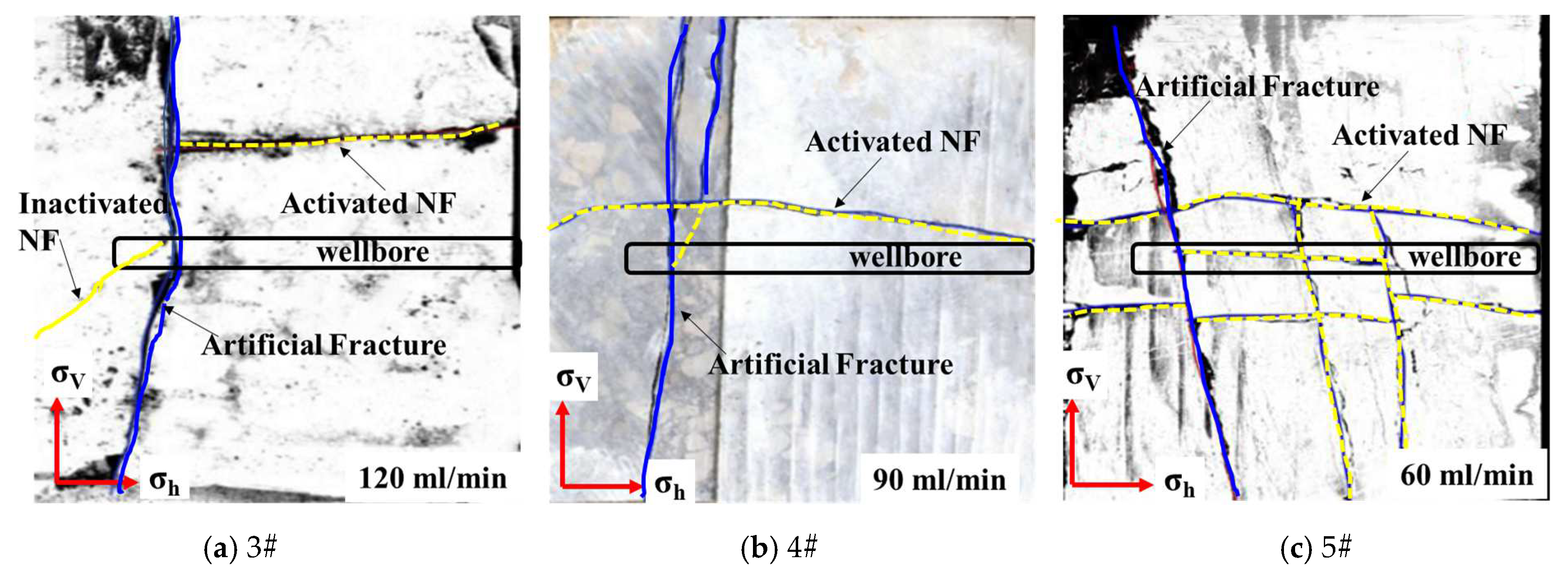

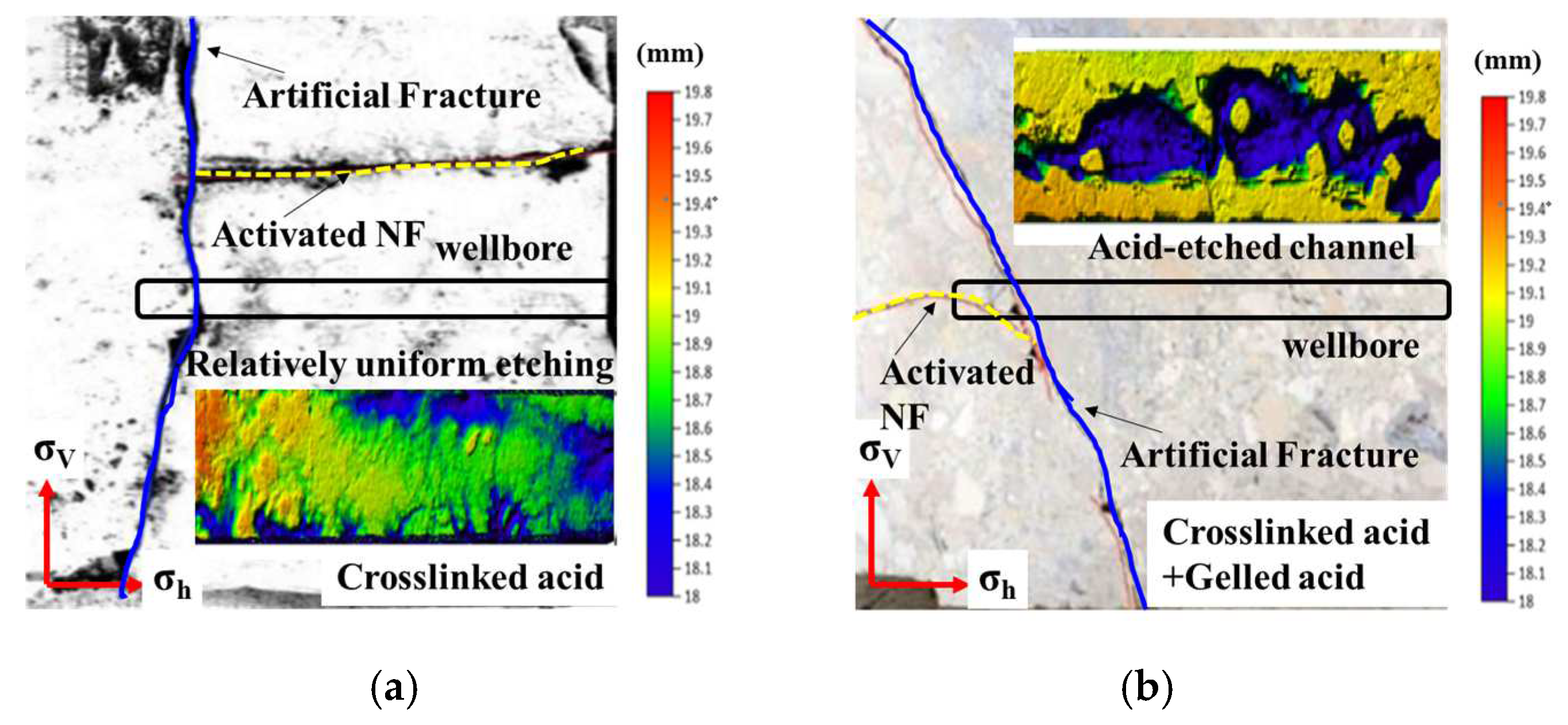

| Specimen No. | Stress (MPa) σh-σH-σv | Flowrate (mL·min−1) | Viscosity (mPa·s) | Fluid Type | Purpose |
|---|---|---|---|---|---|
| 1# | 5-20-25 | 120 | 100 | Fracturing fluid | Effect of fluid types |
| 2# | 120 | 40 | Gelled acid | ||
| 3# | 120 | 70 | Crosslinked acid | ||
| 4# | 90 | 70 | Crosslinked acid | Effect of pumping rate | |
| 5# | 60 | 70 | Crosslinked acid | ||
| 6# | 120 | 100 | Crosslinked acid | Effect of NFs | |
| 7# | 120 | 40/70 | Gelled acid/ Crosslinked acid | Injection method |
Disclaimer/Publisher’s Note: The statements, opinions and data contained in all publications are solely those of the individual author(s) and contributor(s) and not of MDPI and/or the editor(s). MDPI and/or the editor(s) disclaim responsibility for any injury to people or property resulting from any ideas, methods, instructions or products referred to in the content. |
© 2025 by the authors. Licensee MDPI, Basel, Switzerland. This article is an open access article distributed under the terms and conditions of the Creative Commons Attribution (CC BY) license (https://creativecommons.org/licenses/by/4.0/).
Share and Cite
Zhang, Y.; Kuang, J.; Zhang, H.; Zhong, Y.; Dong, S. Experimental Study on the Acid Fracturing Fracture Propagation Law of a Fractured Carbonate Reservoir in the Majiagou Formation. Processes 2025, 13, 695. https://doi.org/10.3390/pr13030695
Zhang Y, Kuang J, Zhang H, Zhong Y, Dong S. Experimental Study on the Acid Fracturing Fracture Propagation Law of a Fractured Carbonate Reservoir in the Majiagou Formation. Processes. 2025; 13(3):695. https://doi.org/10.3390/pr13030695
Chicago/Turabian StyleZhang, Yongchun, Jianchao Kuang, Hao Zhang, Ying Zhong, and Shijie Dong. 2025. "Experimental Study on the Acid Fracturing Fracture Propagation Law of a Fractured Carbonate Reservoir in the Majiagou Formation" Processes 13, no. 3: 695. https://doi.org/10.3390/pr13030695
APA StyleZhang, Y., Kuang, J., Zhang, H., Zhong, Y., & Dong, S. (2025). Experimental Study on the Acid Fracturing Fracture Propagation Law of a Fractured Carbonate Reservoir in the Majiagou Formation. Processes, 13(3), 695. https://doi.org/10.3390/pr13030695





